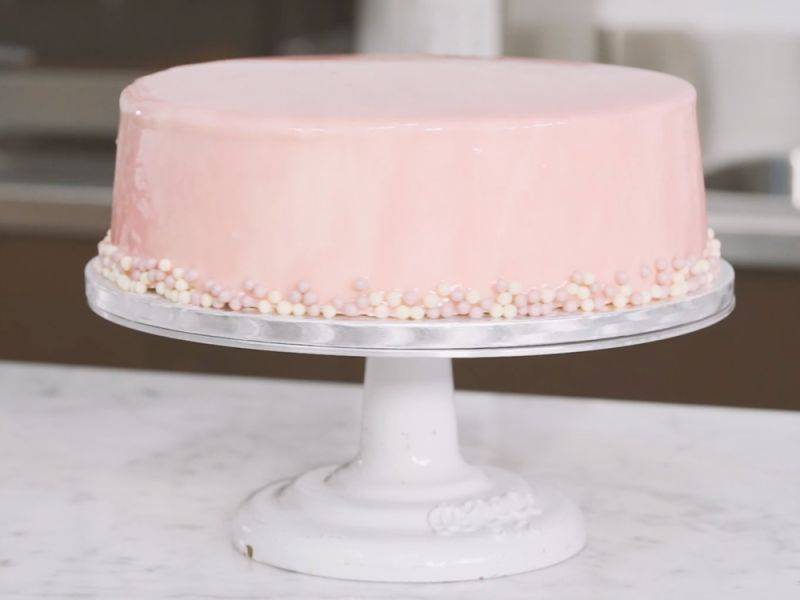
-
Good for freezing
This festive cake is made with almonds, amaretto, and chopped chocolate, layered with white chocolate mousse, and then covered with chocolate and almond buttercream.This festive cake is made with almonds, amaretto, and chopped chocolate, layered with white chocolate mousse, and then covered with chocolate and almond buttercream.This festive cake is made with almonds, amaretto, and chopped chocolate, layered with white chocolate mousse, and then c...
- Shelf life:
- 3 days
- Conservation:
- Refrigerated -4°C
Containing: 7 Components
Almond Chocolate Amaretto Cake
Ingredients: Almond Chocolate Amaretto Cake
-
1.6 lbAll purpose flour
-
0.4 ozbaking powder
-
0.4 ozbaking soda
-
0.3 ozsalt
-
1.0 lbButter, Softened
-
1.0 lbsugar
-
7.9 ozWhole eggs, at 18-20°C (64-68°F)
-
8.8 ozsour cream
-
0.7 ozAlmond extract
-
7.1 ozAmaretto
-
5.1 ozAlmonds, chopped and roasted
-
Q.S.Cooking Spray
Preparation: Almond Chocolate Amaretto Cake
- Spray the cake rings lightly with cooking spray and place them on a silpat lined tray.
- Sift together the flour, baking powder, baking soda, and salt.
- Place the butter in the mixer bowl and cream on medium speed using the paddle attachment.
- Slowly add the granulated sugar.
- Cream this mixture on low speed just until the ingredients are combined and smooth. Stop to scrape the bowl as needed to ensure the mixture is uniform.
- Slowly add the eggs to the creamed mixture in several stages, stopping and scraping as needed to ensure even incorporation.
- Torch the bowl, if needed, to warm the mixture gently to fully incorporate the eggs.
- In a separate bowl, combine the sour cream and almond extract.
- On low speed, slowly add the dry ingredients, alternating with the sour cream mixture.
- Repeat this process until all of the dry ingredients and the sour cream have been incorporated into the batter.
- Slowly add the amaretto to the batter.
- Stop and scrape the bowl as needed to ensure the batter is smooth and well mixed.
- Add in the almonds and chopped chocolate and mix on low speed just until combined.
- Using a kitchen scale, weigh 1000 grams (35.3 oz) of the batter and deposit into each of the two prepared 260 mm (10.2”) cake rings that have been sprayed with cooking spray. Bake the rest of the batter in the prepared 200 mm (7.9”) ring; this layer is perfect to use for cake tastings for weddings or single layer cakes in this case.
- Bake in a 135°C (275°F) convection oven for 40 minutes, or until a toothpick inserted in the center comes out clean.
- Remove the cake from the oven and allow it to cool for a few minutes, as the cake continues to contract away from the cake ring.
- After a few moments, remove the cake rings and allow the cakes to continue cooling. If the cakes are inverted too quickly, this can cause them to crack.
- When the cakes have cooled sufficiently, but are still warm, invert them onto a cooling rack, remove the silpat and allow the cakes to cool completely to room temperature.
- After cooling, the cakes can be wrapped in plastic film and frozen for up to 1 month, or you can proceed with building the cake.
View tools
- Bowl(s)
- Parchment paper
- Mixing bowl (s)
- Scale
- Rack
- Torch
- Silpat
- Small offset spatula
- Metal Tray (s)
- Tabletop mixer, mixing bowl and a paddle attachment
- 27 cm x 4 cm (10.2” x 1.6”) cake ring
- 21 cm x 4 cm (7.9” x 1.6”) cake ring
- Spatula(s)
- Sifter
White Chocolate Mousse
Ingredients: White Chocolate Mousse
-
13.2 ozWhole milk
Preparation: White Chocolate Mousse
- Combine the milk and white chocolate mousse mix together in the mixer bowl.
- Using the whisk attachment, mix briefly by hand to ensure the powder is well hydrated.
- Transfer the bowl and the whisk to the mixer and begin whipping.
- Gradually increase the speed from low to high.
- Stop, if needed, and scrape the bowl to ensure the mixture is uniform.
- Whip on high speed for several minutes until the mousse is light and airy.
- Remove from the mixer and cover with plastic film.
- Refrigerate for about 20 minutes to firm up the mousse.
View tools
- Bowl(s)
- Plastic film
- Tabletop mixer, mixing bowl and a whisk
- Spatula(s)
White Chocolate Buttercream
Ingredients: White Chocolate Buttercream
-
1.0 lbegg whites
-
1.5 lbsugar
-
0.4 ozVanilla bean paste
-
2.6 lbButter, Softened
-
0.2 ozAlmond extract
-
1.8 ozAmaretto
Preparation: White Chocolate Buttercream
- Place the soft butter in a mixer bowl and cream it on medium speed using the paddle attachment until light and smooth. It should have a spreadable texture.
- Meanwhile, gently whisk the egg whites and sugar in a perfectly clean bowl over simmering water until the sugar is dissolved. Be careful not to incorporate too much air at this stage. The mixture should reach 60°C (140°F).
- Transfer the warmed egg white mixture to a perfectly clean mixer bowl and, using the whip attachment, whip on medium speed to release the steam, and then slowly begin increasing the speed. As air is incorporated into the mixer and it thickens, you can whip the mixture faster without it being ejected from the bowl.
- Whip on high speed until firm peaks are achieved. This will take several minutes.
- While the meringue is whipping, the white chocolate can be gently melted in the microwave to 40°C (104°F ).
- Returning to the meringe, the correct texture is achieved when the meringue is lifted out of the bowl, a medium to firm peak stays in place on the tip of the whisk.
- Once the correct texture is achieved, add in the vanilla bean paste and almond extract and return to the mixer and whisk it in on low speed. The bowl should no longer feel warm and should be at cool room temperature. Had we whipped too much air into the meringue while over the water bath, the meringue would have reached proper peak consistency but be too warm to proceed to the next step of adding vanilla and butter.
- Place the paddle from the butter into the meringue and return this bowl to the mixer. Turn the mixer on low speed.
- Using a gloved hand, slowly add all of the soft butter to the meringue while the mixer is running on low speed. By using a gloved hand, the heat from your hands continues to soften the butter and also allows you to double check that the butter is the proper texture.
- As more butter is added to the meringue base, the mixture may appear to split or curdle; do not worry as this is normal.
- As the butter continues to become incorporated, the mixture will become smooth.
- Remove the bowl from the mixer and scrape well using a spatula all the way to the bottom of the bowl to ensure the buttercream is fully homogenized. Return the bowl to the mixer.
- Slowly add the melted white chocolate into the buttercream while the mixer is running on low speed.
- Slowly add the amaretto into the butter cream.
- Remove the bowl from the mixer and scape well.
- At this point, the buttercream is ready to use. You can continue to whip it longer, if desired, to have a lighter and fluffier texture, which is often desired if the buttercream is to be piped as a final decoration.
- If not using immediately, the buttercream can be stored, well protected in a food safe container at room temperature for up to 2 days. It can be refrigerated for up to 7 days or frozen for one month.
View tools
- Cooktop
- Saucepan
- Whisk
- Microwave
- Bowl(s)
- Gloves
- Mixing bowl (s)
- Infrared Thermometer
- Small offset spatula
- Tabletop mixer, mixing bowl and a paddle attachment
- Tabletop mixer, mixing bowl and a whisk
- Spatula(s)
Cake Assembly and Crumb Coating
Ingredients: Cake Assembly and Crumb Coating
-
Q.S.Amaretto simple syrup (1:1)
Preparation: Cake Assembly and Crumb Coating
- Line your work surface in plastic film to make cleanup easier.
- Place a small amount of buttercream on a cake cardboard and set the first cake layer on top of it. Use just enough buttercream to adhere the cake to the board.
- Level the cake layer by trimming the top using a serrated knife.
- Cut the layer in half by slowly going around the layer with the serrated knife, maintaining the same distance between the cake stand and the serrated knife to ensure the cut is level.
- Repeat the same procedure with the second cake layer.
- Slowly brush the first cake layer with room temperature simple syrup allowing it to soak into the cake layer. Repeat this a second time as the cake is quite dense and we want to ensure it stays moist.
- Using an offset spatula, apply a thin layer of buttercream onto the cake layer.
- Prepare your piping bag by placing the coupler inside the piping bag and trimming the tip of the piping bag to fit the coupler.
- Fill the piping bag with the prepared buttercream and pipe a dam around the outer edge of the cake layer.
- Take the white chocolate mousse from the refrigerator and spread a uniform layer on top of the cake layer inside the dam.
- Transfer the second layer of cake on top of the first with the help of a cardboard cake circle.
- Repeat the same process of filling for each layer until all of the cake layers have been utilized.
- Make sure to invert the final cake layer, so that the bottom is facing upwards, which helps to ensure the top of the cake is as level as possible.
- Then, use an offset spatula to crumb coat the cake. This first layer is very thin. Starting with the sides of the cake, spread a thin layer of buttercream all around the cake. You will be able to see the cake through this thin skim coat. This is fine as the purpose of the crumb coat is to trap the loose crumbs and fill in any uneven areas of the cake.
- Place the crumb coated cake into the refrigerator for about 20 minutes to solidify the crumb coat.
View tools
- Cooktop
- Tall recipient
- Piping Bag
- Scissors
- Scraper
- Bowl(s)
- Paper towel
- Plastic film
- Brush
- Large offset spatula
- Small offset spatula
- Saucepans
- Serrated knife
- Cake turntable
- Cake cardboards
- Piping bag coupler
- Cake presentation boards
- Piping tip
- Spatula(s)
Final Coating
- After about 20 minutes, when the crumb coat is firm, remove the cake from the refrigerator.
- Finish icing the cake with the buttercream using an offset spatula.
- Start on the sides of the cake so that you can ensure the cake has an even layer of buttercream all the way around. If you ice the top of the cake first, you will not be able to see how much buttercream is on the sides of the cake.
- Once you have applied an even coating of buttercream to the side of the cake, smooth it using the offset spatula and fill in any gaps or low places.
- Then, ice the top of the cake, trying to match the thickness of the buttercream with that on the sides of the cake.
- Using a bench scraper, follow the carboard at the base of the cake to perfectly smooth the buttercream on the sides of the cake.
- Use the bench scraper to also smooth the top of the cake.
- Spot check the cake, and if needed, fill in any remaining gaps with more buttercream using the offset spatula.
- Once the buttercream is even on the cake, clean your offset spatula well and then place it briefly into warm water and then dry it.
- Use the warmed spatula to do the final smoothing of the buttercream and remove any small excess amounts that might still be present.
- After finishing, any remaining buttercream can be used to fill or crumb coat future cakes.
- Place the cake into the refrigerator for at least 20 minutes to completely set the buttercream.
View tools
- Cooktop
- Paper towel
- Large offset spatula
- Saucepans
- Cake turntable
- Bench scraper
White Chocolate Mirror Glaze
Ingredients: White Chocolate Mirror Glaze
-
0.6 ozGelatin sheets, 200 bloom
-
Q.S.Water, cold for gelatin hydration
-
5.1 ozwater
-
8.4 ozsugar
-
1.8 ozglucose syrup
-
7.1 ozsweetened condensed milk
-
Q.S.titanium dioxide
Preparation: White Chocolate Mirror Glaze
- Bloom the gelatin sheets in cold water. Place each sheet separately into the cold water so that each sheet is properly hydrated.
- Set aside and allow the gelatin to hydrate for at least 10 minutes.
- Combine the sugar, water, and glucose in a medium saucepan and warm over low-medium heat.
- While the syrup is heating, partially melt the chocolate in the microwave and set aside.
- Once the sugar is dissolved, add the condensed milk to the saucepan.
- Remove the bloomed gelatin from the ice water and gently squeeze it to remove any excess water and then add the
- gelatin to the warm mixture in the saucepan.
- Stir well and allow the gelatin to melt into the warm liquid.
- Bring this mixture to a boil.
- Strain the warm mixture over the partially melted chocolate and emulsify using an immersion blender.
- Sift the titanium dioxide powder into the glaze and stir it in well with the spatula.
- Allow the glaze to cool to 31°C (88°F).
View tools
- Cooktop
- Saucepan
- Strainer
- Immersion blender
- Microwave
- Bowl(s)
- Mixing bowl (s)
- Spatula(s)
- Sifter
Final Glazing and Decoration
Ingredients: Final Glazing and Decoration
-
Q.S.Pink Gel Color
Preparation: Final Glazing and Decoration
- Remove the cake from the refrigerator and, using your fingers, gently round the top edge of the buttercream at the top of the cake.This helps to give the cake a very smooth and rounded look.
- Remove the cake from the turntable using two offset spatulas and set it on the glazing rack on a plastic lined tray.
- Insure that the temperature of the glaze is at 31°C (88°F).
- Divide the glaze into three containers, one for each color that you want to make.
- Tint one container of glaze light pink and a second container a darker shade of pink.
- Leave the third container of glaze the original white color.
- In an empty container, pour in a small amount of white glaze, followed by some of the darker pink glaze.
- Continue adding glaze, alternating the colors to end up with a swirled container of glaze.
- Pour the swirled glaze on top of the chilled cake, starting by pouring down the sides of the cake first and finishing in the center of the cake.
- Use a spatula as needed to spread the glaze evenly over the top of the cake. If needed, warm the top of the cake gently,
- using a heat gun, to pop any air bubbles that might be present in the glaze.
- Allow the glaze to set for a minute and trim off any drips from the bottom/underside of the cake board.
- Transfer the iced cake to its final presentation board using a clean offset spatula by placing it underneath the cake
- cardboard and gently lifting it off the glazing rack and setting it onto the prepared cake drum.
- Garnish the cake with the white chocolate and strawberry crispeals.
View tools
- Metal Tray
- Tall recipient
- Offset spatula
- Plastic film
- Heat gun
- Rack
- Infrared Thermometer
- Bowl (s)
- Spatula
- Cake board
- Cake turntable
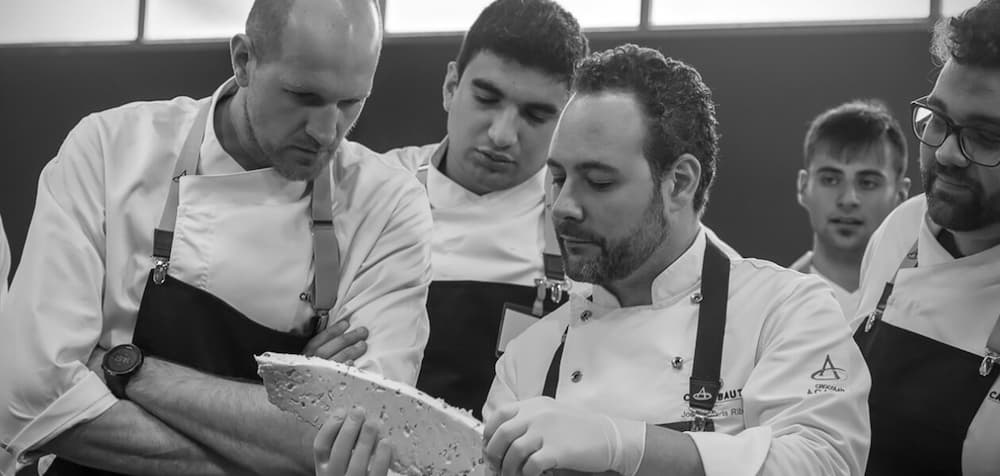
Facing Problems with your Creations?
- Find troubleshooting guides & tutorials
- Chat live with an advisor chef and find the right solution to your challenges


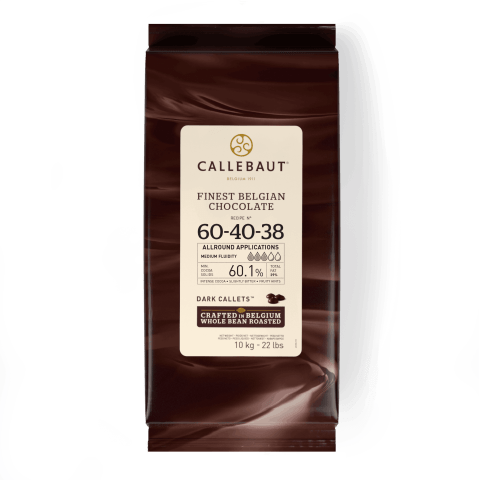

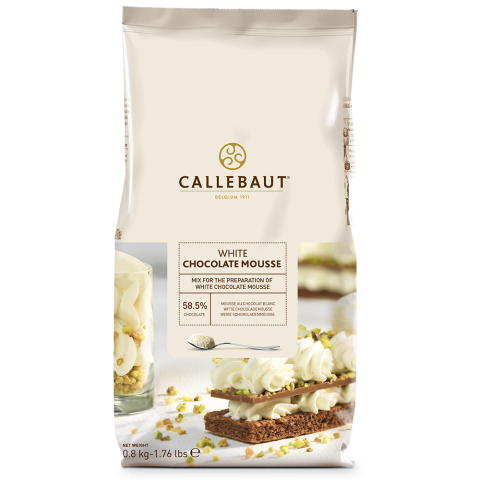


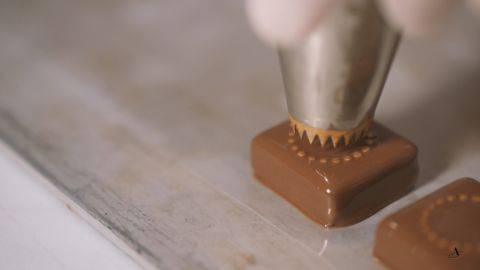
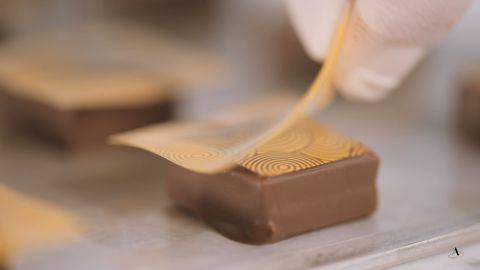
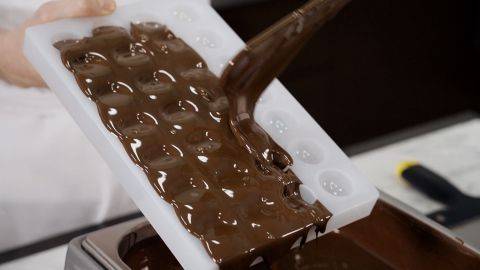

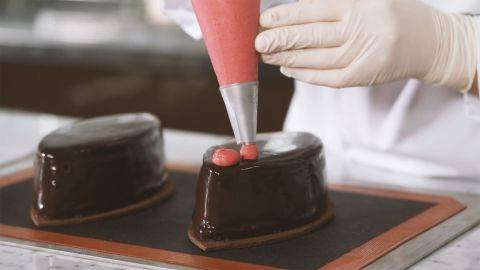

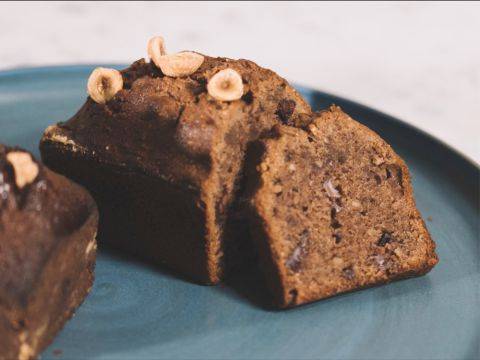
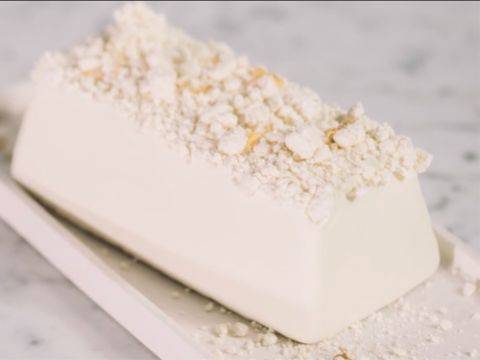

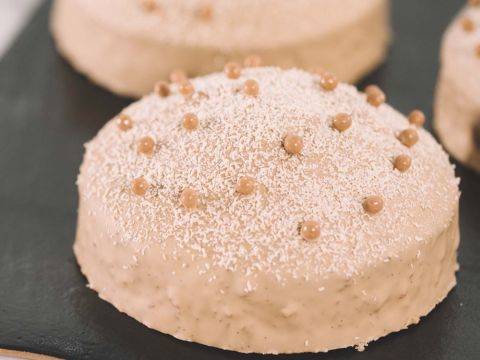
Comments